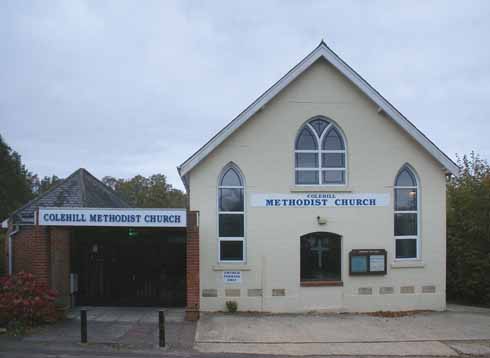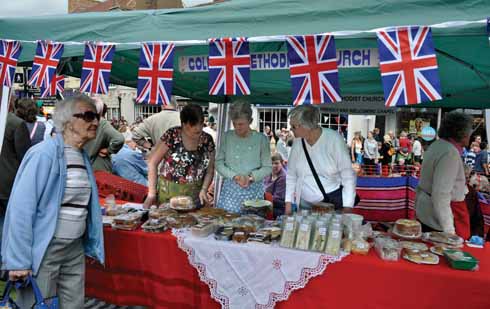From ‘primitive’ beginnings
Paul Allen charts the course of Methodism in Colehill from its beginnings to the present day and marks the centenary of Colehill's Methodist Church
Published in December ’12
It seems only appropriate that a group of churchgoers calling themselves Primitive Methodists should meet for worship in a mud-built hut, but these were the early days of the Methodist Church in the village of Colehill, just outside Wimborne, in the latter part of the 19th century.
In May 2013, Methodists at Colehill will be celebrating the centenary of their chapel building in Lonnen Road and looking back across the years of change in the village church.
Those Primitive Methodists, singing hymns and praying in their mud hut, were ‘primitive’ in the sense that they were the product of open-air worship meetings, simple and straightforward in their faith and without the ‘finery’ of the established church. These open air meetings began after the death of Methodism founder John Wesley. Wesley himself, after his conversion on May 24, 1738, when he felt his heart ‘strangely warmed’ by the love of God, had travelled the length and breadth of the country to preach the gospel in the open.
Methodism was a nickname that just stuck after people remarked on how brothers John and Charles Wesley were so methodical in their ways and the denomination was noted for its concern for social welfare. William Booth, founder of the Salvation Army, was a Methodist and preached in the Methodist Church in Wimborne in the early 1900s.

Although the mock-Tudor Anglican church of St Michael and All Angels pre-dates the 'new' Methodist chapel by 20 years, its building was still some 40 years after the Methodists' mud-built hut. Picture Pauline Stevens
In late 1912 the time came for the Colehill congregation to plan a move to bigger and better things, leaving the dubious comforts of their hut – known as Little Lonnen Chapel in Four Wells Road – and to set about building a new chapel near the crossroads in the centre of the village. Twenty perches of Bankes Estates land, on a yearly rent of £1, were leased and builder William Habgood constructed the new chapel for £400 (plus £3 for the purchase of oil lamps). It was opened in May 1913 when, it was reported, Mrs Dorcas Habgood played the harmonium outside the chapel, accompanied by three fiddlers. Methodism had always been known for the enthusiasm of its music and hymn-singing.

The opening ceremony of the Methodist Chapel in 1913; the sign on the right is for William Habgood's building firm, who built the chapel
The chapel was heated by two stoves, one at each end of the building, which could be very temperamental at times. One member of the congregation recalls: ‘In the very cold winter days there was a competition to see who arrived early enough to sit around the stove. Eventually, as the stoves and their faces became redder and redder, one by one they started moving to seats further away.’ And the only lighting came from those £3 lamps hanging from the ceiling.
Visiting preachers were clearly a tough breed and in those early days, when owning a car was not the norm, they would cycle to Colehill from as far afield as Wareham, Lytchett and Poole, no doubt asking for God’s strength to make that final mile or so up the steep hill before endeavouring to get their breath back and lead the service.
As the community of Colehill grew with more housing being built, so did the church. Women’s Fellowship, youth groups, Sunday School, charabanc outings, Young Wives, summer picnics, trips to the beach… all became regular fixtures in the busy church calendar. The late Dot Humphries (née Moody), recalling her memories of the church for the 75th anniversary, wrote this evocative description of the time: ‘Going to chapel played a big part in our lives. Anniversaries, Easter with new dresses and big straw hats, Harvest with an auction of the gifts a night or two later, with baked potatoes to eat. Prayer meetings followed the Sunday evening services with loud “Amens” and “Hallelujahs”. Good old days.’
A native of Guernsey in the Channel Islands played a big part in those ‘good old days’. She was Pamela Le Poidevin, known to all in the church as Sister Pam and who took the unusual course of setting up home in a second-hand caravan alongside the church from which to conduct her ministry as Deaconess and resident caretaker.
Pamela moved south after five years in Manchester and arrived at Colehill with a bicycle and nowhere to live. From her retirement home back in Guernsey, Pamela recalls: ‘There was no accommodation – the church authorities didn’t worry too much about how a deaconess lived – and I was in lodgings in a bedsit which was no good at all… no phone, no proper
living accommodation, and the circuit couldn’t provide a house.’
Salvation came in the form of a holiday caravan, offered to the circuit and towed from its pitch at Burton Bradstock to Colehill. ‘It had six berths but I had to put the bed down every night,’ says Pamela, ‘and in the winter the Calor gas cylinder outside would freeze. I must confess I wonder how I coped in such cramped conditions but I look back on many happy memories of what was my first taste of independence in my own home. It was of course handy so far as the chapel’s ‘mod cons’ were concerned and the vestry at times became a guest room.’
Pamela spent eight years in her Colehill caravan, during which time her bicycle was upgraded to a moped and, eventually, a Morris 1000 car whose registration number was 23. ‘How I appreciated the words of the 23rd Psalm which I always associated with it in my early days of motoring.’
As the population of Colehill grew, the church needed to expand. Pamela, who was later to move on to ministry in Devon, had already overseen the removal of the church pews to allow more space in the chapel for a wide variety of events. ‘When I first went to the chapel it was full of pews and nothing else,’ she remembers. Taking pews out of a church can be a sensitive business – in the Church of England such action can meet with strong protests from the more traditionally-minded members of the congregation and it is not unknown for the incumbent considering such action to be hauled before a consistory (church) court for a decision to be made.
In this case, the operation was carried out rather more painlessly. The pews were unscrewed from the floor and stacked up outside the chapel, where passers-by wondered what was going on and whether the chapel was closing down, says Pamela.
But putting chairs in the chapel made it ‘dual-purpose’, a place both for worship and for reaching out into the families of the growing community around in Colehill. The new arrangements, along with improved kitchen and toilet facilities, meant that the chapel building could become a home to a Young Wives’ Group, formed by Sister Pam in late 1963. Activities included quizzes and outings, candlelight services and Christmas parties, and the Young Wives went on to start an over-60s group, helping with refreshments and entertainment for the older members.
Moving forward in another direction, the chapel was, in 1967, registered for the solemnization of marriages and the first couple to be married there couldn’t have been more local – they were Mr and Mrs T Speed, of Lonnen Road.
By the early 1970s, it was decided to expand further to meet church needs. After the removal of the caravan, a temporary building was purchased…the first church hall. It was opened in May 1972 with an expected lifespan of ten years. One member of the congregation recollects: ‘The building gave marvellous service to the chapel and community and increased its lifetime by nearly 50 per cent.
‘After giving us such good service it was quite sad to see it go and, worse still, when I saw it all broken up. After being blown off the lorry by a very strong wind, it landed on a small piece of grass just past the Cross Keys!’

The original entrance door is now a low-key etched glass window. Four of eight foundation plaques are also visible in this shot.
But bigger and better things were to come. From the land beside the chapel emerged a new, permanent and larger hall, opened in May of 1983 and still in use today. As well as providing space for meetings and activities (two table tennis team playing in the Bournemouth and District League use the hall both for weekly practice and for match nights), the hall is a regular gathering place for members of the Methodist chapel, who meet to eat together either over breakfast or lunch on various special dates through the year, when the appetising odour of fried bacon or roast lamb drifts around the 100-year-old premises.
From mud hut to modern, centrally-heated amenities, the Methodist church in the village has come a long way. And as Pamela Le Poidevin, now retired in her native Guernsey, says: ‘Colehill has always been a church where newcomers have been welcome and encouraged to make their own particular contribution to the Christian fellowship.’




